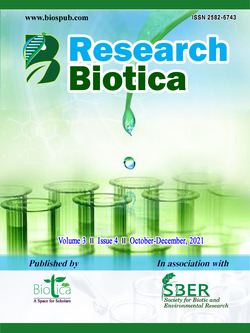
Weekly Trend Detection in Meteorological Data for Crop Response
N.S. Vithlani*
Research Testing and Training Centre (RTTC), Junagadh Agricultural University, Junagadh, Gujarat (362 001), India
J.J. Makwana
Centre for Natural Resources Management, S.D. Agricultural University, Sardarkrushinagar, Gujarat (385 506), India
G.V. Prajapati
Research Testing and Training Centre (RTTC), Junagadh Agricultural University, Junagadh, Gujarat (362 001), India
DOI: https://doi.org/10.54083/ResBio/3.4.2021/188-194
Keywords: Comparisons Mann-Kendall (MK) test, Sen’s slope, Spearman rank correlation (SRC) Test, Turning point, Warming Trend
Abstract
Climate is perceived to be changing worldwide and there has been growing concern towards the direction and magnitude of these changes. Greenhouse gases are responsible for maintaining earth's surface temperature suitable for sustaining life, but excess emission of GHGs increase the earth’s surface temperature and causing global warming. Globally, over the past several decades, about 80% of human-induced carbon dioxide emissions came from the burning of fossil fuels, while about 20% from deforestation and associated agricultural practices. The objective of the study are to document the ability of the turning test, MK test, Sen’s Slope and Spearman rank correlation to detect the weekly trend, and to discuss the different between statically significance and practical significance. Conclusions are parted in different season like Kharif, Rabi and Summer season. In which, overall found that the minimum temperature trend is increases during kharif season. In Rabi season the both temperature are increase so at that time the CWR requirements are more. If the minimum temperature is increase its effect on crops (Wheat and cumin) growth and yield is decrease in summer season. The high temperature from flowering and from podding increase flower numbers, but reduced fruit set, resulting in reduction in reproductive number, pod number and pos yield. High temp also reduced the total dry matter when imposed at flowering, but not at podding. However, pod weights were reduced by high air temperature during the flowering and podding.
Downloads
not found
Reference
Anandhi, A., Srinivas, V.V., Nagesh Kumar, D., Nanjundiah, R.S., 2009. Role of predictors in downscaling surface temperature to river basin in India for IPCC SRES scenarios using support vector machine. International Journal of Climatology 29(4), 583-603.
Burn, D.H., Hag Elnur, M.A., 2002. Detection of hydrologic trends and variability. Journal of Hydrology 255, 107-122.
Dahmen, E.R., Hall, M.J., 1990. Screening of Hydrological Data. International Institute for Land Reclamation and Improvement (ILRI), Netherlands. Publication No. 49. p. 58.
Haan, C.T., 1977. Statistical Methods in Hydrology. The Iowa State University Press, Ames, Iowa. p. 378.
Hirsch, R.M., Slack, J.R., 1984. A nonparametric trend test for seasonal data with serial dependence. Water Resources Research 20(6), 727-732.
Hirsch, R.M., Slack, J.R., Smith, R.A., 1982. Techniques of trend analysis for monthly water quality data. Water Resources Research 18(1), 107-121.
Kendall, M.G., 1975. Rank Correlation Methods, 4th Edition. Charless Griffin, London, UK. p. 272.
Khaliq, M.N., Ouarda, T.B.M.J., Gachon, P., Sushama, L., St.-Hilaire, A., 2009. Identification of hydrologic trends in the presence of serial and cross correlations. A review of selected methods and their application to annual flow regimes of Canadian rivers. Journal of Hydrology 368, 117-130.
Kundzewicz, Z.W., Robson, A.J., 2004. Change detection in hydrological records - A review of the methodology. Hydrological Sciences Journal 49(1), 7-19.
Lettenmaier, D.P., 1976. Detection of trend in water quality data from record with dependent Observations. Water Resources Research 12(5), 1037-1046.
Mann, H.B., 1945. Nonparametric tests against trend. Econometrica 13, 245-259.
Pant, G.B., Rupa Kumar, K., 1997. Climates of South Asia. John Wiley & Sons, Chichester (ISBN 0-471-94948-5). p. 320.
Reeves, J., Chen, J., Wang, X.L., Lund, R., QiQi, L., 2007. A review and comparison of changepoint detection techniques for climate data. Journal of Applied Meteorology and Climatology 46(6), 900-915. DOI: https://doi.org/10.1175/JAM2493.1.
Sen, P.K., 1968. Estimates of the regression coefficient based on Kendall’s tau. Journal of the American Statistical Association 63, 1379-1389.
Tabari, H., Marofi, S., Aeini, A., Hosseinzadeh Talaee, P., Mohammadi, K., 2011. Trend analysis of reference evapotranspiration in the western half of Iran. Agricultural and Forest Meteorology 151, 128-136.
Xiong, L., Shenglian, G., 2004. Trend test and change-point detection for the annual discharge series of the Yangtze River at the Yichang hydrological station. Hydrological Sciences Journal 49(1), 99-112.
Zhang, X., Harvey, K.D., Hogg, W.D., Yuzyk, T.R., 2001. Trends in Canadian streamflow. Water Resources Research 37(4), 987-998.
